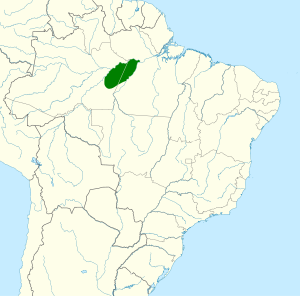Brown-chested barbet facts for kids
Quick facts for kids Brown-chested barbet |
|
|---|---|
| Conservation status | |
| Scientific classification | |
| Genus: |
Capito
|
| Species: |
brunneipectus
|
 |
|
The brown-chested barbet is a colorful bird. It is also known as the cinnamon-breasted barbet. This bird belongs to a group called New World barbets. You can only find it in the central Amazon Basin in Brazil.
Contents
About This Bird
Scientists group living things based on their features. This is called taxonomy. The brown-chested barbet is a unique species.
Family Tree
Long ago, scientists thought the brown-chested barbet was the same as two other birds. These were the black-spotted barbet and the gilded barbet. But since the late 1900s, they are known as separate species. They are still very close relatives. The brown-chested barbet is a single species. It does not have any subspecies.
What It Looks Like
The brown-chested barbet is about 18 centimeters (7 inches) long. A male bird weighs around 58 grams (2 ounces).
Male Birds
Male brown-chested barbets have a dull gold color on their head. They have a wide black patch that goes through their eyes. Their back is black with yellow stripes. Their throat is a yellowish-white color. Below the throat, they have a cinnamon-colored band on their chest. Their belly is yellow to olive green. It has faint stripes.
Female Birds
Female barbets look similar to males. But their colors are not as bright. They have more yellowish marks on their wings. Their throat is cinnamon with black spots.
Where It Lives
The brown-chested barbet lives south of the Amazon River. You can find it between the Madeira River in the west and the Tapajós River in the east. We do not know how far south its home goes. This bird lives high up in the trees of wet forests. It prefers the very top layer, called the canopy.
How It Behaves
What It Eats
The brown-chested barbet eats different things. It likes insects and other small creatures called arthropods. It also enjoys eating fruit. This bird finds its food by climbing on vines. It also hops along branches and twigs. Sometimes, it joins groups of different bird species. They all look for food together. This is called a mixed-species foraging flock.
Reproduction
Scientists believe the brown-chested barbet lays eggs from March to June. We do not have much more information about how this bird raises its young.
Its Song
The brown-chested barbet has a special song. It sounds like a fast "hoo" trill. It is made of many short notes. You can hear its song online here.
Its Safety Status
The IUCN is a group that checks on animals' safety. They say the brown-chested barbet is of "Least Concern." This means it is not in danger right now. However, its home area is small. Also, we do not know much about its needs or how it breeds. Because of this, some people think we should watch this bird closely. Its safety status might need to be checked again in the future.
See also
 In Spanish: Cabezón pechipardo para niños
In Spanish: Cabezón pechipardo para niños


